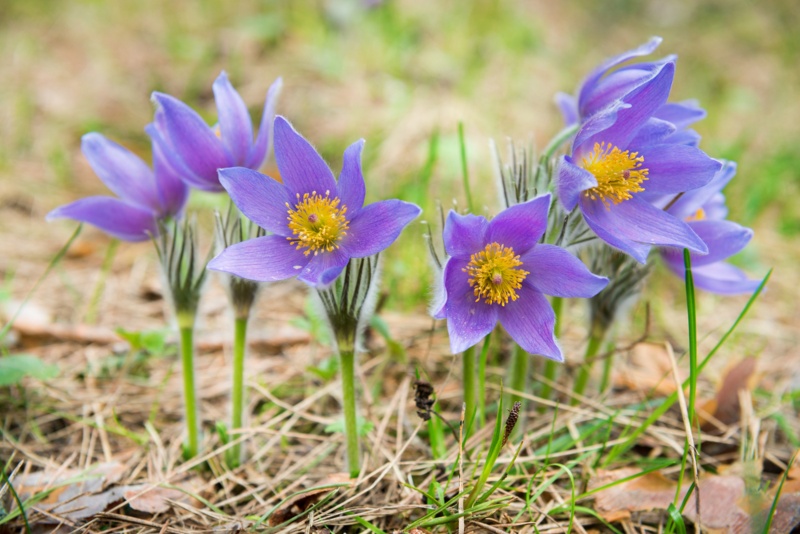
These flowers have beautiful, star-shaped blooms that many people love for their shades of blues, purples, and even reds in various varieties of the plant.
They will grow in the cooler temperatures of zones 4 through 8. It blooms in the early springtime and keeps blossoming for over a month. Get used to plenty of buzzing when they’re in bloom, as these are a honeybee favorite.
These plants grow up to about 1′ tall and about 10″ to 15″ in width. They are great for small spaces that need some color.
Light and Temperature Requirements
The pasque flower loves to be planted in full sun, but it will tolerate some shade or dappled sun. They prefer cool temperatures, but they are not tolerant of freezing temperatures.
Watering
These plants need an average amount of moisture. They need more water in areas with higher temperatures, as the water will evaporate faster. However, watering them too much can lead to root rot. If you have a moister climate, it’s a good idea to plant them in sloping areas so that the water can drain away easily. If you get a moderate amount of rain, you likely won’t have to water them at all unless you have a summer that is hotter than normal. If you have just planted your Pasque flower, it will need to be watered frequently for the first couple of weeks to help its roots dig down into the soil and so that it can start growing its taproot.
Soil & Fertilizing
These plants like alkaline soil that drains extremely well. If your area gets a lot of water, another idea is to use raised beds for them so that their roots won’t sit in water, leading to them rotting. They prefer humus soil, but there is no need to fertilize them. You may, however, need to treat the soil so that it offers better drainage. Mixing small rocks into the soil can help accomplish this, as can adding sand to the soil.
Deadheading and Pruning
If you deadhead the flowers once they have wilted, you can cause the plant to bloom for a longer period of time. The Pasque flower grows white, fuzzy mop heads that carry the seeds. There is no need to deadhead these if you want it to reseed. However, many people deadhead these to either prevent more from germinating, to use them in indoor arrangements, or to sow the seeds elsewhere.
Growing From Seed
Collect the white seed heads when you see them- they are large and prominent, so it should be easy to find them and remove them from the plant. Then, sow the seeds right away. If you want until the next winter or spring, you are not likely to have much luck with germination. When you plant the seeds, cover them with a light sprinkle of soil. Water the seeds regularly and protect them from the sun. Choose the area where you plant them carefully, considering the amount of sun the spot gets, how well it drains, and whether it’s the final place you will let them grow and thrive. You should have plenty of shoots in less than a month after sowing.
Planting Tip
The Pasque flower grows a large, deep taproot, so it doesn’t like to be transplanted once it has established this. Seedlings can be easily transferred, but an adult plant doesn’t like being uprooted and may not survive the change of location.




